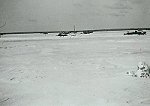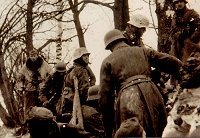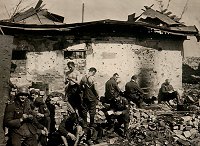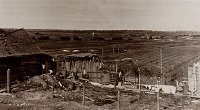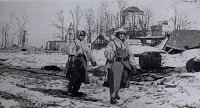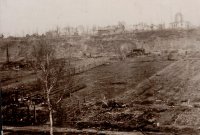
By Stijn David and Sebastián Bianchi
The Battle of Cholm
At the beginning of January 1942 , the German offensive had come to a grinding stop in the Northern Sector of the Eastern Front, and the Russians soon took over the initiative. The 3rd Shock Army and the Soviet 11th Army forced a breach of German lines on the 8th of January and units from the German 16th Army (Generaloberst Busch ) began their retreat under constant pressure, allowing the Soviets to make large gains in a minimum of time. In the Demjansk area a complete army corps became trapped and found itself encircled from 8th February 1942 until the 21st April 1942 (see also article Demjansk Shield). Numerous other units became encircled or were simply overrun, and through this critical situation the German front lines folded back over about 100 km.
To keep the offensive going the Russians needed to capture the strategic City of Cholm on the Lovat River, in the Kalinin section of Russia. The Germans, from their perspective, could ill afford to loose the strategic point either as it was crucial to planned missions in relieve of the encircled II Armeekorps. Perhaps as importantly, Cholm belonged to a defense line that was Hitlers' starting point for further offensive operations; his plans for a second assault towards Moscow and Leningrad would be severely compromised should Cholm fall into Soviet hands. With the importance of the city in mind, Hitler gambled on one of his famous "defend until the last man" orders.
During the fluid first days of the battle German units concentrated with extreme rush in the small town under the command of the famous Generalmajor Theodor Scherer (commander of the 281 Sicherungsdivision), who gave his name to this group: "Kampfgruppe Scherer" (see picture 1).
Some of the units were:
- Parts of the 123 ID (Gren Regt. 416 , Art.Regt 123).
- Parts of the freshly arrived 218 ID (staf Gren.Regt. 386 with the 13 & 14 Kompanie Gren.Regt 386)
- A bicycle battalion from the Aufkl.Abt. 218
- The (Gebirgs) Jagdkommando 8 (Commander Hptm.Spittäler)
- Parts of a Res.Pol.Btl Cholm
- A Marine Kraftfahr Unit (not known by name until this date)
Various other units or parts of units (mostly from stragglers) were present in the pocket as well. During the course of the struggle, there was also an influx of a few new troops from parts of units flown in, as well as personnel attached to the K.G.z.b.V 172 (such as the glider pilots). It is stated in the German literature that over 60 units where present in the pocket, varying in size from small to large.
|
|
|
Propaganda Postcard of Generalmajor Theodor Scherer ( SD Collection ) |
The leaders of this mixed battle group as it is known today can be summarized as follows :
- Commander : Generalmajor Theodor Scherer (281. Sicherungs Division)
- Battle command:
- Oberstleutnant Johannes Manitius Ia
- Oberstleutnant Hans Freiherr von Bodenhausen Ic :
- Major Grabs
- Artillery Observers:
- Oberleutnant Feist (s. Art. Abt. 536 )
- Leutnant Joachim Dettmann ( Art. Regt. 218 )
- Medical Staff : Stabsarzt
- Dr. Ocker Oberarzt
- Dr. Huck
(Note - this list is in by no means complete and can only give an overview of some important positions in the German defense)
The actual encirclement of the fortress Cholm began on January 21st, 1942. During the course of the battle the Germans were only able to reestablish ground contact once, during the first days of the siege (with parts of the MG. Btl. 10). In the following days the Russians closed the encirclement and tightened the noose, and from then until relief came (05/05/1942- exactly 105 days) the Cholm Pocket resisted in isolation. The strength of the pocket is reported to be approximately 5500 men (1*), although no exact number is known to this day. There were also a number of civilians left who were unable to flee before the encirclement was closed. The Russians placed three entire Divisions around the city and launched attack after attack in attempts to break the German resistance inside the pocket .
|
Click on image to enlarge |
|
| This map shows the Cholm Pocket, during the beginning stage of the battle. This drawing shows major buildings and defense positions; the red part representing the ground that was captured by the Russians during the course of the battle. | |
The German troops were encircled in an area that was about 2 Km at the widest point (see also map above). The pocket was under constant fire from Soviet artillery, and it lacked natural protection.
Cholm was a little Russian city of about 10,000 inhabitants during peacetime. It was divided into 2 parts by the Lovat River, which had high beddings. Although most of the houses were made out of wood, some of the larger buildings were constructed from stone. These included some dignitaries houses, the Church (used as artillery observer point), and the former Russian Prison (called "GPU Gefangenis"). The last mentioned building became a main defending post and proved of capital importance in holding of the city (see number 2 on the map). The pocket Cholm can be divided into 4 sections (or in German "Abschnitte") namely, North , East, South and Western Part. The main battles from the pocket Cholm took place in the East part. Looking at the above maps it can be clearly seen that it was in this section where the German troops lost the most ground, and consequently it was in this section that most Germans where killed during the siege.
The encircled troops had almost no heavy weapons, and had to defend with a few 3.7 Pak , one 5 cm Pak, a few Mortars and their machine guns and small arms. There heavy weapons did not have sufficient ammunition, and the trapped Art.Rgt 123 was used as Infantry during the conflict.
To compensate for the lack of armor, the Germans where able to place an unconventional artillery emplacement outside the city of Cholm, which proved to be of great value during the course of the battle. This artillery grouping was under the command of General Uckermann and was from that point on named "Gruppe Uckermann". The artillery stronghold was placed about 10 Km to the West of Cholm in the vicinity of Dubrowo/Tarakonovo. It was an actual bridgehead that could be attacked by the Sovjet forces from both North and South. This Artillery stronghold was unconventional due to the fact that the batteries (Art.Regt. 218 and s.Art.Abt. 536) were placed before the actual German front line, a position that caused an enormous amount of casualties for these artillerists, but one that was necessary in order to propel a protective steel shower the garrison holding Fortress Cholm. To give an estimate of the rounds that where fired into the Russian lines from Gruppe- Uckermann, it can be stated that over 1,000 German shells could be fired from this emplacement per day.
The fire from these Artillery units was directed from inside the city of Cholm by 2 courageous artillery officers that were flown in during the beginning stage of the battle. Oberleutnant Feist (s.Art.Abt. 536) and Leutnant Joachim Dettmann (Art.Regt. 218) played a very important role in guiding the artillery aid which rained from outside. Their main task was to continuously search for suitable Russian targets in and around the city. Once a possible target was spotted a runner had to report the target to the Radioman inside the pocket (situated in the HQ: so called Weisses Haus), who had to transmit the target to the Gruppe Uckermann. Needles to say this caused a time loss (in the quickest way, it took about 10 minutes) and occasionally mobile targets where missed because of the time difference between spotting and firing.
Another important role into the keeping of the Fortress Cholm was played by the Luftwaffe which made a continuous effort to re-supply the encircled troops with all needed goods. In order to relieve pressure, the air force of the Reich was also to attack enemy positions with both bomber and dive bomber units whenever the weather was clear enough (under the command of Luftflotte 1).
A chief problem for the German re-supplying force was the fact that there was no airfield available due to the limited size of the pocket. To circumvent this predicament, the German Luftwaffe transport units used an improvised landing strip of about 1000 Meters just outside the North-Western part of the city. This landing strip was located in "no-man" land and so it is easy to understand why the first landings from the German re-supplying Luftwaffe units attracted the prompt attention of Russian troops, resulting in massive losses amongst the landing troops . The landing strip soon became a graveyard of German Ju 52's. One example of the savages of the battle and the bravery of the German transporting units; in the middle of February 1942 Hitler ordered that 7 Ju 52 fly a complete German Company inside the pocket. Their mission was to land, let the troops disembark and then fly away again. Five from the seven Junkers where so badly damaged in their missions that they where not able to return to their home base and had to be abandoned. In all, the mission resulted in a loss off 71% of the aircrafts, with the surviving crews becoming a part of Kampfgruppe Scherer. Due to the high loses, the German Luftwaffe command was forced to change tactics.
The idea of dropping Paratroopers was discarded off the bat; because of the very limited size of the pocket, this would only result in a massive losses of good men. Therefore the Luftwaffe decided to maintain the flow of supplies by dropping containers (the Kampfgruppe Scherer needed about 60 supply containers a day to survive). Glider planes, type Go 242, were also employed and all the gliders where considered permanently lost when landed. The first Go 242 landed at Cholm on 2/16/1942. The glider planes landed in Cholm either in the evening (about 19.00 Hours) or in the very early morning to lower the risk of being spotted and shot down by enemy fighter planes. A glider plane has almost no defense against such enemies. These flights brought highly needed supplies; medication, arms, ammunition and even new personnel. For example between 3/9/42 and 3/12/42 a complete company was brought into the pocket, namely 2./Gren.Rgt. 409, with glider planes Type Go 242. Whenever these glider planes circled toward the ground, the Germans placed suppressing fire in the form of an attack from a Stuka, or artillery on the Soviet lines. This held down the enemy and prevented these glider troops from attracting much fire before even landing. The pilots who landed inside the pocket, after landing and re-supplying, had the additional task of becoming infantry fighting side by side with the other encircled troops.
The Luftwaffe effort can be placed in statistics as following :
- 2122 missions where flown to drop supply containers by He 111 Units (involved units : KG 4 , I./KG 53 , K.G.z.b.V. 5)
- Of 91 Ju 52 that started towards Cholm (first Phase of the battle) , 27 Ju 52 where counted as destroyed around the city of Cholm (about 30 %)
- 81 Glider planes were deployed to re-supply Cholm (these where part of the K.G.z.b.V 172), from which at least 56 reached there goal .
The encircled troops repelled above 100 Infantry attacks and no less then 42 Tank assaults during the 105 days of encirclement. An advantage for the defending German troops was the fact that the Russians could not effectively concentrate high tank numbers around the city to start offensive actions and they could only use the smaller and lighter tanks such as the T60 due to the effect of the weather on the ground.
A critical point in the battle came at the beginning of May when the Russians undertook a major attack and came within 100 meters of reaching the high walls of Lowat river from the eastern part. Had they succeeded in reaching these banks then the encirclement could certainly be broken from inside, which is what happened in the Welikji Lucki encirclement (1943) and resulted in the loss of the city as well as irreplaceable experienced troops.
Another main problem that became increasingly acute during the course of the battle were the wounded. Wounded men could be transported out of the encirclement in the beginning of the battle due to the Ju 52 Transport planes that where assigned to fly newly troops in and bring wounded man back (according to some sources they where able to bring home about 700 wounded, a task that can be called a real success) but as stated above this transporting solution became impossible as the battle evolved. From that point forward the Germans were not able to transport wounded personnel out of the city and from day to day the number of wounded increased. It is also striking that when the battle became fiercer the number of places where the wounded could be brought became smaller (the pocket was reduced heavily in size both from retreating towards other positions and units simply overrun by Russians ), so this situation soon became dramatic.
After the main hospital post (in the beginning located in the eastern part of the city) burned down and with most buildings becoming ruins the wounded were transported to the western part (which was the most secure area during the whole battle) in the so called "Haarnadelcurve". The disadvantage of this was that the buildings where made of wood and with no cellars, so whenever a shell exploded near or hit some of the buildings there was no cover for the wounded from wood fragments and splinters. It was absolutely no rarity that a person became wounded a second or third time by such fragments before being able to recover from the previous combat wound.
This extreme situation demanded the best from the medical staff and both Dr. Huck and Dr. Ocker (plus other medical personnel not known by name) should be recognized as extraordinary . The mortality rate under the German troops became very high (killed in action over 25 %) and the number of the wounded became even greater: about 2200 soldiers (minimum 40 %), these numbers are only crude numbers as exact numbers are not known, and one must keep in mind that many of the badly wounded who survived the battle died shortly afterwards due to received wounds in German hospitals or became disabled for life.
In the morning of May the fifth, 1942, came the end to the actual encirclement, thanks to the efforts of the Gren Regt. 411 (under the lead of Oberstleutnant Tromm ) and a few Sturmgeschutze. During the encirclement the Germans outside the pocket never stopped trying to open the city of Cholm but failed in al the cases (main reasons; not sufficient troops and weather conditions). For the encircled troops the battle was not over as they had to fight quite a few more days with their liberators to stabilize the front (until about mid-June), and these days of Battle cost the life of many more soldiers (amongst them the liberator Oberstleutnant Heinrich Tromm , Killed in action on 6/18/1942 , about 2 km. Northwest of Cholm and buried on 6/21/1942 ) . On 5/5/1942 when the relief came the pocket was heavily reduced in size (see maps of the Cholm area) and there were only about 1500 men able to fight (from a total of 5500). The city of Cholm was held another 2 years in German hands and was abandoned on February 1944 when the German lines where folded back in a retreating movement. During these 2 years the fighting never cease but could be held and the Russians did not try to force a major breakthrough at this point of the front. For many of the survivors the suffering was still not over, because of unhygienic situations the deadly illness "Flecktyphus " broke out amongst civilians and spread quickly in the rows of the defenders causing many of the lucky survivors long stays in various hospitals .
The fierce battle resulted in a rain of awards to the defenders, and in the creation of a new award , the "Cholmshield" with this institution order. The following other high awards where presented to the defenders during the battle or shortly afterwards;
Oak Leaves:
-
05.05.1942 : Generalmajor Theodor Scherer (received them personally from Hitler)
Knights Cross:
-
20.02.1942 : Generalmajor Theodor Scherer ( Kdr.Kampfgruppe Scherer)
-
23..02.1942 : Oberleutnant Werner Gerhard ( Jagd Kdo 8 )
-
18.03.1942 : Hauptmann Albert Bieker ( I.R. 386) Killed in action at Cholm on 01.05.1942
-
03.04.1942 : Oberstleutnant Johannes Manitius ( Kdr. I.R. 386 )
German Cross in Gold :
-
30.05.1942 : Freiherr Hans von Bodenhausen
Numerous lower grades of awards where also awarded (Iron cross 2nd & 1st class , wound badges, Infantry Assault badges, etc). These are, however, no longer traceable.
( 1 * ) The numbers of the encircled persons are varying and depends on the source that one is using, Dr. Klietmann gives a number from about 5500 persons, J. Hörrman gives a number of 6200 and another sources gives the number of about 6000 , none of the above mentioned authors give however sources for their research and may be wrong in a way , therefore it is best not to give exact numbers as these are not known until today.
![]()
© Copyright Wehrmacht-Awards.com LLC |

